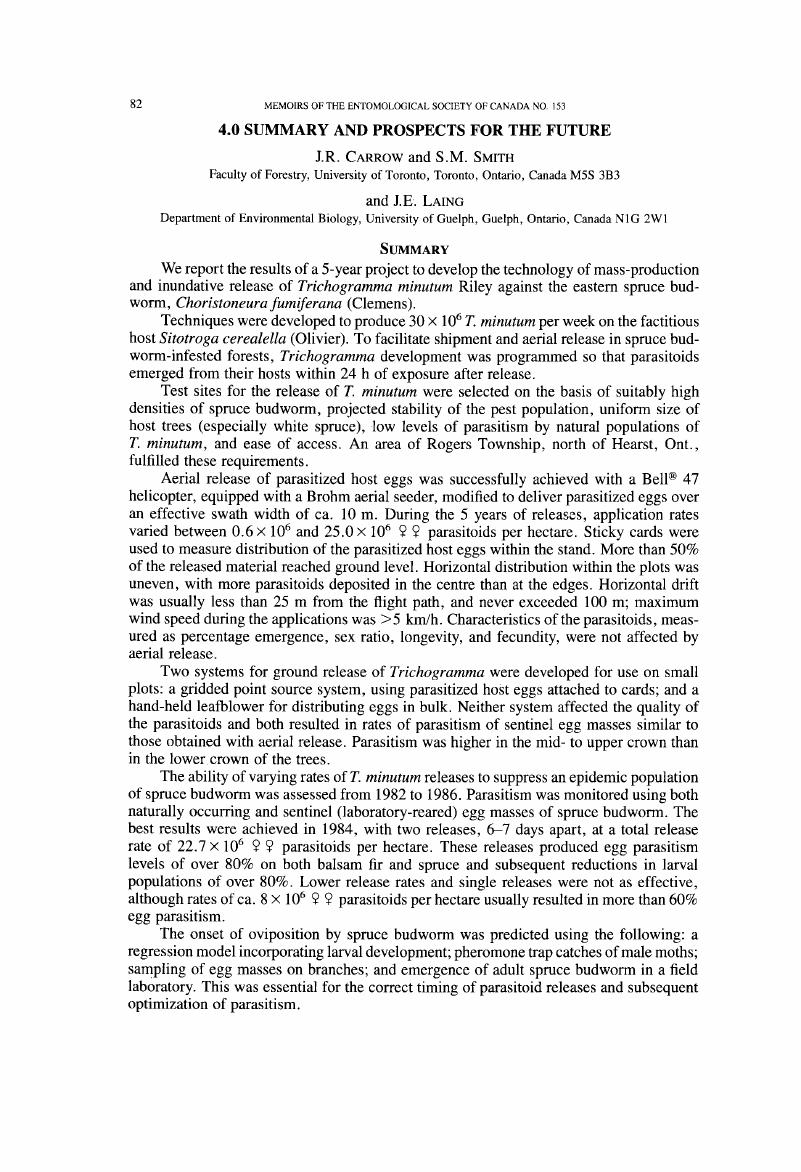No CrossRef data available.
Article contents
4.0 SUMMARY AND PROSPECTS FOR THE FUTURE
Published online by Cambridge University Press: 31 May 2012
Abstract
An abstract is not available for this content so a preview has been provided. Please use the Get access link above for information on how to access this content.

- Type
- Other
- Information
- The Memoirs of the Entomological Society of Canada , Volume 122 , Supplement S153 , 1990 , pp. 82 - 87
- Copyright
- Copyright © Entomological Society of Canada 1990
References
Belmont, R.A., and Habeck, D.H.. 1983. Parasitoids of Dioryctria species (Pyralidae: Lepidoptera) coneworms in slash pine seed production areas of north Florida. Fl. Ent. 66: 399–407.Google Scholar
Bigler, F., Meyer, A., and Bossnart, S.. 1987. Quality assessment in Trichogramma maidis Pintureau et Voegele reared from eggs of the factitious hosts Ephestia kuehniella Zell. and Sitotroga cerealella (Olivier). J. appl. Ent. 104: 340–353.Google Scholar
Boller, E.F. 1979. Behavioral aspects of quality in insectary production, pp. 153–160 in Hoy, M.A. and McKelvey, J.J. (Eds.), Genetics in Relation to Insect Management. The Rockefeller Foundation. 179 pp.Google Scholar
Dorais, L., and Kettela, E.G.. 1982. A review of entomological survey and assessment techniques used in regional spruce budworm, Choristoneura fumiferana (Clem.), surveys and in the assessment of operational spray programs. Eastern Spruce Budworm Council Report. October. 43 pp.Google Scholar
Hsiao, K.J. 1981. The use of biological agents for control of the pine defoliator, Dendrolimus punctatus (Lepidoptera, Lasiocampidae), in China. Protection Ecol. 2: 297–303.Google Scholar
Knipling, E.F, and McGuire, J.U. Jr., 1968. Population models to appraise the limitations and potentialities of Trichogramma in managing host insect populations. USDA Tech. Bull. 1387. 44 pp.Google Scholar
Li, L.Y. 1983. Research and utilization of Trichogramma in China. Guangdong Entomological Institute Publication. 21 pp.Google Scholar
Manweiler, S.A. 1986. Developmental and ecological comparisons of Trichogramma minutum and Trichogramma platneri (Hymenoptera: Trichogrammatidae). Pan-Pacific Ent. 62(2): 128–139.Google Scholar
Mills, N.J., Schlup, J., and Schonberg, F.. 1986. Can. For. Serv. Annual Project Report, pp. 32–33. CAB Intern. Instit. Biol. Cont. 45 pp.Google Scholar
Morrison, R.K. 1976. New developments in mass production of Trichogramma and Chrysopa spp. Beltwide Cotton Prod. Res. Conf. Proc.Google Scholar
Morrison, R.K. 1986. Mass production of Trichogramma pretiosum. Southwest. Ent. Suppl. 8: 21–27.Google Scholar
Pak, G.A. 1986. Behavioral variations among strains of Trichogramma spp. A review of the literature on hostage selection. J. appl. Ent. 101: 55–64.Google Scholar
Pak, G.A., Guis, H.C.E.M., Heck, I.C.C., and Hermans, M.L.G.. 1986. Behavioral variations among strains of Trichogramma spp.: host-age selection. Entomologia exp. appl. 40: 247–258.Google Scholar
Paul, S.A. 1988. Communication and cooperation: Forest management into the 1990's. 1988 E.B. Eddy Distinguished Lecture, Faculty of Forestry, University of Toronto, Toronto, Ont.Google Scholar
Roush, R.T. 1979. Genetic improvement of parasites, pp. 97–105 in Hoy, M.A., and McKelvey, J.J. (Eds.), Genetics in Relation to Insect Management. The Rockefeller Foundation. 179 pp.Google Scholar
Smith, S.M. 1985. Feasibility of using the egg parasitoid, Trichogramma minutum Riley, for biological control of the spruce budworm. Ph.D. thesis, University of Toronto, Toronto, Ont.221 pp.Google Scholar
Smith, S.M., and Hubbes, M.. 1986 a. Isoenzyme patterns and biology of Trichogramma minutum Riley as influenced by rearing temperature and host. Entomologia exp. appl. 42: 249–258.Google Scholar
Smith, S.M., and Hubbes, M.. 1986 b. Strains of Trichogramma minutum Riley. I. Biological and biochemical characterization. Zeit. angew. Ent. 101: 223–239.Google Scholar
Smith, S.M., Hubbes, M., and Carrow, J.R.. 1987. Ground releases of Trichogramma minutum (Hym.: Trichogrammatidae) against epidemic populations of the spruce budworm. Can. Ent. 119: 251–263.Google Scholar
Tsankov, G., Charnev, T., Lakterieva, L., Bochev, N., and Ficheva, E.. 1980. The eastern Rhofope strain of Trichogramma isolated from Rhyacionia buoliana and the possibility of using it in biological control. Gorskostopanska Nauka. 17: 56–61.Google Scholar
Walter, S.T. 1985. Eine neue Art aus der Verwandtschaft von Trichogramma embryophagum (Htg.): T. zeira-pherae n. sp. (Hym., Trichogrammatidae). Ent. Nach. Berichte. 29: 275–276.Google Scholar
Whitten, M.J. 1979. The use of genetically selected strains for pest replacement or suppression, pp. 31–40 in Hoy, M.A., and McKelvey, J.J. (Eds.), Genetics in Relation to Insect Management. The Rockefeller Foundation. 179 pp.Google Scholar
Whitten, M.J. 1986. Molecular biology — its relevance to pure and applied entomology. Symposium: Genetics in Entomology. Ann. ent. Soc. Am. 79: 766–772.Google Scholar




